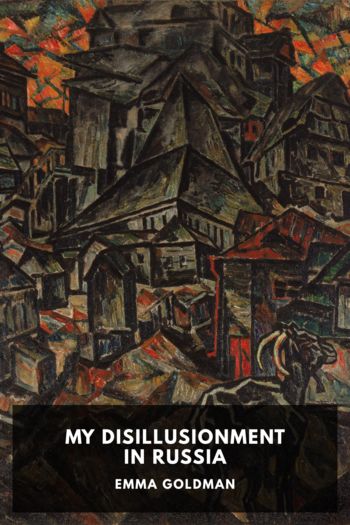Journey from St. Petersburg to Moscow Irina Reyfman (snow like ashes .TXT) 📖

- Author: Irina Reyfman
Book online «Journey from St. Petersburg to Moscow Irina Reyfman (snow like ashes .TXT) 📖». Author Irina Reyfman
In 1766, Radishchev was one of a select group of twelve young noblemen sent to Leipzig University to further their education. Each of them was given room and board and a bursary of eight hundred rubles, a substantial sum. The young people studied natural philosophy, law, logic, geography, physics, and mathematics; they also learned languages—German, French, and Latin. Among their instructors were first-rate European scholars and scientists, including the philosopher Ernst Platner and poet Christian Gellert. Radishchev also studied medicine. The connections he makes in his major writings between forms of sensibility and sensation may have been rooted in his education at Leipzig University. The Age of Reason was also an Age of Sensibility, and the human propensity for sympathy and empathy was seen as a matter of hardwiring in the body as much as a product of a refined education (discussions of pedagogy in this period in Russia, as well as in Western Europe, considered these parallel influences). The foundation for Radishchev’s knowledge of a wide range of Enlightenment ideas about the body and soul, as well as about political economy and the law, was laid during his Leipzig years.
The period of study at Leipzig was formative not only educationally but also politically and emotionally. Radishchev developed firm friendships with some of his fellow students, most especially Fyodor Ushakov (1748/49–1770), whom he would later commemorate in an important biography, The Life of Fyodor Ushakov (1789). The biography recounts how Russian students, with Ushakov as their ringleader, rebelled against their corrupt supervisor to protest poor living conditions. This experience was seminal for Radishchev, who later traced his mature thinking about political action and legitimate forms of protest back to this event. The Life of Fyodor Ushakov also describes the titular character’s death from venereal disease, stressing his courage in the face of death and connecting his firm behavior with his leadership qualities. Radishchev is unusually frank about Ushakov’s libido and the sexually transmitted disease that prematurely killed him. The topic of prostitution and syphilis recurs in episodes of the Journey that consider passions, including sexual passions, as an important factor in human behavior.3 The friendship with Ushakov was thus a turning point for Radishchev, providing both a political and an emotional education.
On his return to Russia, Radishchev and two others of his cohort, including his friend Alexei Kutuzov, the future Freemason and eventual dedicatee of the Journey, served briefly in the Senate before entering military service. Radishchev served as a military lawyer until his retirement in 1775. Soon after retirement, Radishchev married Anna Vasilyevna Rubanovskaya (who died prematurely in 1783). He resumed his service career in January 1778 as a civil servant in the Commerce College, with the rank of collegiate assessor. He held this post under Alexander Vorontsov, the well-educated, progressive nobleman, diplomat, and brother of Catherine’s confidante Ekaterina Dashkova. At the time, Vorontsov was president of the Commercial College and had recruited Radishchev to work for the Commission on Commerce. He remained a loyal patron to Radishchev during his career and, especially, after his arrest and exile in 1790.
A civil servant of distinction and ability who had a practical grasp of policy implementation (he visited the port cities on the Baltic to see things with his own eyes), Radishchev seems never to have put a foot wrong. When the government passed gubernatorial reforms in 1780, Radishchev was seconded to State Councillor Dal, the director of St. Petersburg Customs, and assumed oversight for trade entering the port at St. Petersburg. In this capacity he was said to have commanded the respect of his colleagues for his incorruptibility, a conspicuous virtue when contrasted with the venality of officialdom much illustrated in the Journey. He made steady progress up the ranks, achieving several promotions in the early 1780s. In 1789 he was designated director of St. Petersburg Customs.
Arrested a month after the publication of the Journey, Radishchev was imprisoned in the notorious Peter and Paul Fortress, investigated, and condemned to death in late July. In early September, Catherine commuted the death sentence, replacing it with exile to Siberia. On September 8, 1790, in chains and under guard, Radishchev began his journey to Ilimsk, a small fortress not far from the Angara River. Thanks to Vorontsov, the chains were soon removed, and on his way to Siberia Radishchev spent significant time in Moscow, Nizhny Novgorod, Tobolsk, and Irkutsk, which eased his journey. His sister-in-law, Ekaterina Rubanovskaya, and his two younger children joined him in Tobolsk. Rubanovskaya became Radishchev’s common-law wife (marriages between in-laws were prohibited), with whom he had three children. She died on the family’s way back to European Russia in 1797.
Radishchev arrived in Ilimsk in January 1792 and left in February 1797, having been granted permission to live in Nemtsovo, one of his





Comments (0)